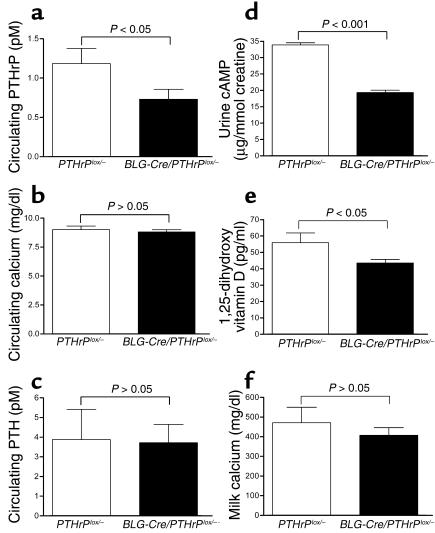Figure 3.
Calcium metabolism in BLG-Cre/PTHrPlox/– mice. Circulating PTHrP(1–34) levels (a) were significantly lower (P < 0.05) during lactation in BLG-Cre/PTHrPlox/– mice (0.73 ± 0.13 pM, n = 7) than in PTHrPlox/– controls (1.18 ± 0.19 pM, n = 3). Circulating calcium (b) and PTH (c) concentrations were not significantly different between PTHrPlox/– and BLG-Cre/PTHrPlox/– mice during lactation. Probably as a result of the reduced circulating PTHrP, urinary cAMP levels (d) and circulating 1,25-dihydroxy vitamin D concentrations (e) were also significantly reduced. Milk calcium (f) was not significantly different in BLG-Cre/PTHrPlox/– mice and controls. Bars represent the mean values of 3–12 samples. PTH concentrations were 3.8 ± 1.5 pM in PTHrPlox/– controls and 3.7 ± 0.9 pM in BLG-Cre/PTHrPlox/– mice. Although statistically insignificant, both plasma calcium and milk calcium are slightly lower in BLG-Cre/PTHrPlox/– mice (8.8 ± 0.2 mg/dl and 406.7 ± 39.4 mg/dl, n = 14) than in controls (9.0 ± 0.3 mg/dl and 471 ± 78.5 mg/dl, n = 9). Urinary cAMP was 33.9 ± 0.6 μg/mmol creatinine in PTHrPlox/– controls (n = 7) and 19.3 ± 0.8 μg/mmol creatinine in BLG-Cre/PTHrPlox/– mice (n = 11), while 1,25-dihydroxy vitamin D levels were 55.9 ± 5.9 pg/ml in PTHrPlox/– mice (n = 3) and 43.5 ± 2.2 pg/ml in BLG-Cre/PTHrPlox/– mice (n = 6).

